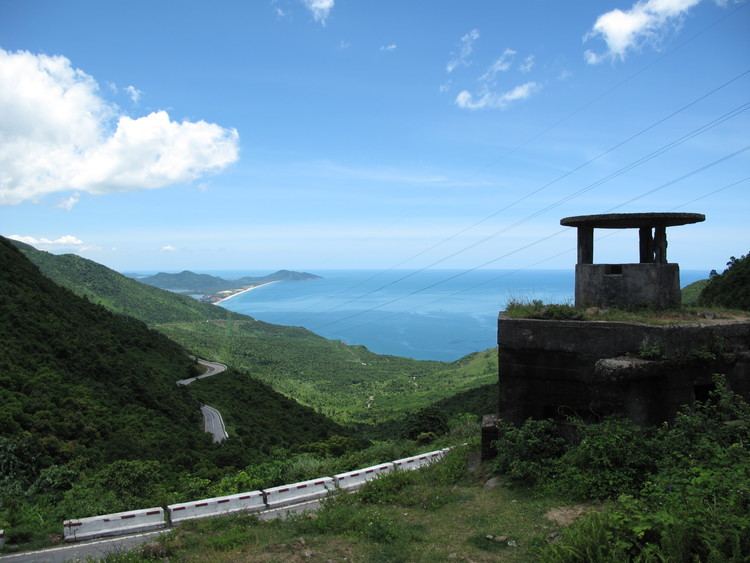Province Thừa Thiên-Huế Province | Elevation 496 m Road National Route 1A | |
 | ||
Similar Marble Mountains, Hải Vân Tunnel, Pagoda of the Celestial, Mỹ Sơn, Imperial City - Hue | ||
The Hải Vân Pass (Vietnamese: Đèo Hải Vân, [ɗɛ̂w ha᷉ːj vən], "ocean cloud pass"), is an approximately 21 km long mountain pass on National Route 1A in Vietnam. It traverses a spur of the larger Annamite Range that juts into the South China Sea, on the border of Đà Nẵng and Thừa Thiên–Huế Province, near Bạch Mã National Park. Its name refers to the mists that rise from the sea, reducing visibility. Historically, the pass was a physical division between the kingdoms of Champa and Đại Việt.
Contents
- Map of HE1BAA3i VC3A2n Pass tt LC483ng CC3B4 PhC3BA LE1BB99c Thua Thien Hue Vietnam
- Overview
- History
- Transport
- Accidents
- References
Map of H%E1%BA%A3i V%C3%A2n Pass, tt. L%C4%83ng C%C3%B4, Ph%C3%BA L%E1%BB%99c, Thua Thien Hue, Vietnam
The twisting road on the pass has long been a challenge for drivers traveling between the cities of Huế and Đà Nẵng. Since the completion of Hải Vân Tunnel, traffic flow and safety have improved. The pass has been the scene of at least two of Vietnam's most serious rail accidents, and at least one air crash.
Overview
The Hải Vân Pass crosses over a spur of the Trường Sơn (Annamite) Range that emerges from the west and juts into the South China Sea, forming the Hải Vân Peninsula and the adjoining Son Tra Island. The pass, which once formed the boundary between the kingdoms of Đại Việt and Champa, also forms a boundary between the climates of northern and southern Vietnam, sheltering the city of Da Nang from the "Chinese winds" that blow in from the northwest. During the winter months (November–March), for instance, weather on the north side of the pass might be wet and cold, while the south side might be warm and dry.
The pass is renowned for its scenic beauty. Presenter Jeremy Clarkson, host of the BBC motoring programme Top Gear, featured the pass during the show's 2008 Vietnam Special, calling the road "a deserted ribbon of perfection—one of the best coast roads in the world."
History
Hải Vân Pass has been of major strategic importance in this history of Vietnam, and for a long time represented a major barrier to any land army that attempted to move between the northern and central regions of the country.
During the 1st century A.D., the Chinese general Ma Yuan (Mã Viện), after pacifying northern Vietnam, advanced south and established the southern border of the Han (Hán) empire by setting up columns of bronze, possibly at Hải Vân. Ma Yuan also left behind some Chinese military families to hold the frontier. When the Han empire collapsed at the end of the 2nd century, the local kingdom of Linyi (Lâm Ấp), the predecessor to the medieval polity of Champa, was created by a petty frontier bureaucrat of the Han administration, probably in the area of modern Huế somewhat to the north.
Transport
The pass is crossed by two main transport routes: Vietnam's main north–south highway, National Route 1A, and the North–South Railway. The road crosses over the mountain more or less directly, climbing to an elevation of 496 m (1,627 ft) and passing south of the 1,172 m (3,845 ft) high Ai Van Son peak, while the railway hugs the coastline more closely, passing through a series of tunnels along the way. Since its opening in 2005, the Hải Vân Tunnel—the longest tunnel in Southeast Asia—offers an alternative road across the pass, reducing travel times by at least an hour.
Accidents
Besides its beauty, the pass is also renowned for its difficulty. A poem by Nguyễn Phúc Chu (1675–1725) describes Hải Vân as "the most dangerous mountain in Vietnam" (Vietnamese: Việt Nam hiểm ải thử sơn điên). Visibility on the pass is often reduced by the eponymous mists that rise from the sea. Along with the road's winding route through the pass, this posed a serious challenge for drivers before the construction of the Hải Vân Tunnel. The Hai Van Pass has also been the scene of at least two of Vietnam's most serious rail accidents, and at least one air crash.
